
Men's Collared Dress Shirts - The Ultimate Guide
Every man needs a selection of dress shirts (collared shirts with stiff collars and long sleeves) in his wardrobe.
However, when it comes to dress shirts, the devil is in the details, so make sure you read this article before you invest in some new ones.
Dress shirts are a menswear essential but not all are created equal. Make sure you are choosing the correct dress shirt for your body, outfit and occasion.
Summarize with AI
Quick Links
Frequently Asked Questions
What are the types of dress shirts all men should have?
For me, there are only two types of dress shirts that every man should have in his closet:
Oxford button-down dress shirts
Semi-spread collar dress shirts
What is a semi-spread collar?
Refer to the image below. In my opinion, this is the best looking shirt collar, so it's important that you know what it looks like.

Why should I go for a semi-spread collar over other types?
The collar of your shirt is very important as it makes or breaks an outfit. The collar of a shirt borders your face, so this is the first thing people see when looking at you since our natural tendency is to look at the face/head and move down.
Also, the type of collar informs the viewer, often unconsciously, what the rest of your outfit should be and how to perceive you.
Button Down Collar = I know this is a casual event, so I’m wearing what’s appropriate.
Point Collar = My mommy dressed me.
Spread Collar = I might know my shit, but I may not.
Semi-Spread Collar = I like you!
Why should I avoid shirts with point collars?
A point collar, the most common one you’ll see in stores, simply doesn’t look good on most guys because it doesn’t fit most faces or body types.
I rarely dress my clients in them because it’s just not worth the hassle when there’s something that looks good on all men.
Whenever I see someone wearing a point collar, they almost always shouldn’t be wearing it because it’s not for them.
What is the difference between Oxford button-down dress shirts and semi-spread collar dress shirts?
Oxfords can be worn as part of casual outfits while semi-spread shirts definitely have a 'dressier' appearance.
I've gone into greater detail below.
Can a dress shirt have short sleeves?
Absolutely not! If you want short sleeves, then go for a crewneck t-shirt or a polo shirt.
Is a polo shirt a dress shirt?
Those polo shirts have a smarter appearance than t-shirts, they are not considered to be dress shirts.
Dress Shirt Mistakes Most Men Make
Trust me, there's nothing worse than seeing a guy with a sloppy dress shirt. Make sure you don't make these mistakes:
Going for a spread or point collar.
I've outlined why in the next section.Wearing your shirt untucked.
The majority of dress shirts are designed to be worn tucked into your pants and wearing them untucked can take away from their smart appearance.Wearing bold-colored shirts.
Avoid choosing colors that are too bright or colorful, as these can be super difficult to pair with the other items in your wardrobe.Rolling up your sleeves incorrectly.
Women love it when you flash a little bit of forearm but so many guys roll up their sleeves incorrectly so they look sloppy. Here's how to correctly roll up your sleeves.Not wearing an undershirt.
An undershirt provides you with a base layer that will hide stains, chest hair, and dark nipples. Wearing one will help prevent visible or minimize sweat patches and deodorant stains and will ultimately make your shirts last much longer.
Want to see all the mistakes to avoid specifically for your age, height, body type, and skin tone? Check out our Essential Capsule Wardrobe App.
Anatomy of a Dress Shirt
Here are some of the key things to look out for when shopping for your next dress shirt:
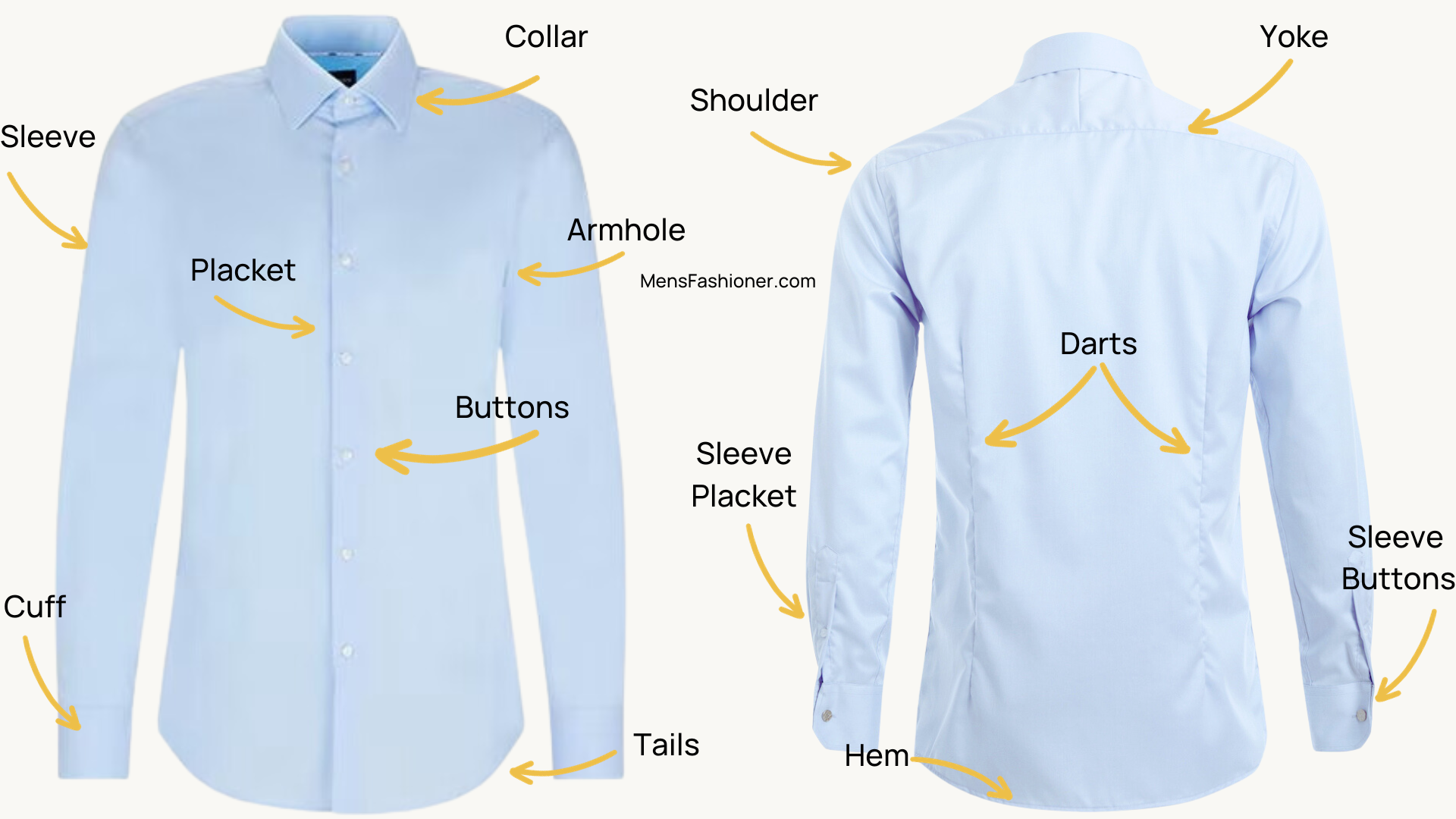
Collar
When it comes to dress shirts, there are a range of different collar options to choose from, but I will always default to a semi-spread collar.
More details regarding shirt collars can be found in the 'Different Types Of Dress Shirt' section below.
When buttoned, the collar of your shirt should just graze your neck without constricting it.
You should be able to comfortably fit one finger inside your buttoned collar without it choking you.
If turning your head causes the collar to turn with it, it’s too tight.
Yoke
The yoke is a panel of fabric located on the back of the shirt.
It can also be on the front of Western-styled shirts, but these are not dress shirts.
Basically, everything between the shoulder seam and the horizontal line of stitching at the back of the shirt qualifies as the yoke.
It is cut separately from the rest of the shirt to allow for improved movement and a more defined shape.
If there’s an additional line of stitching in the middle of the collar running vertically (as shown in the image above), that’s called a 'split yoke'.
You should always buy quality if you’re opting for a shirt with a yoke.
Cheap thread/poor stitching can shrink when the shirt is washed, making it uncomfortable to wear and unattractive to look at.
Shoulder
The shoulder seam will be the main factor in determining whether your shirt properly fits you or not.
The seam should end just where your shoulder starts to slope down toward your bicep area.
Any higher and the shirt is too small.
Any lower and the shirt is too large.
Armhole
The armholes are where the sleeves are attached to the body of the shirt.
Your armholes should be comfortable in motion and should not be so tight that they cut into your armpit.
However, like other formal items, dress shirts are not meant to give you a full range of motion.
This is why you don't wear these clothes every day unless you have to for work.
They also shouldn’t be so loose that there’s a bunch of excess fabric around the armpit.
Sleeve
The fit of your sleeves is surprisingly important.
They should not be so tight that you can see the details of your arms.
However, they should also not be so loose that they billow and bunch at the wrist.
When you bend your arm, your cuff should not move up more than an inch above your wrist.
If it does, it’s likely that the shirt is too small.
Never, ever, go for a dress shirt with short sleeves.
Placket
A placket (also known as a 'button stand') is a seam of fabric that extends down from the shirt collar to the hem.
Basically, it's the part of your shirt where the buttonholes are placed.
Never go for a dress shirt with a concealed placket (which hides the buttons on the front of the shirt).
Darts
Darts are tapered seams sewn into the back of the shirt.
Their main purpose is to remove any excess fabric for a slimmer, more form-hugging fit.
These are particularly great for skinnier men or guys who want to display their athletic physique.
Buttons
Cheaper shirts will have thinner, plastic buttons, while higher-quality shirts will have more substantial ones, often made from mother-of-pearl.
For the best possible appearance, always go for a dress shirt with white buttons.
Buttons in a contrasting shade just never look good.
Sleeve Placket
Similar to the torso placket, the sleeve placket is a strip of fabric with holes for the sleeve buttons near the cuff.
Make sure your sleeve placket, like the rest of your shirt, doesn't have contrasting stitching.
Sleeve Buttons
Like the buttons on the front of your shirt, you want to make sure to go for white buttons on your sleeve.
Personally, I think a two-button sleeve always looks best.
One-button and three-button sleeves just look off.
Cuff
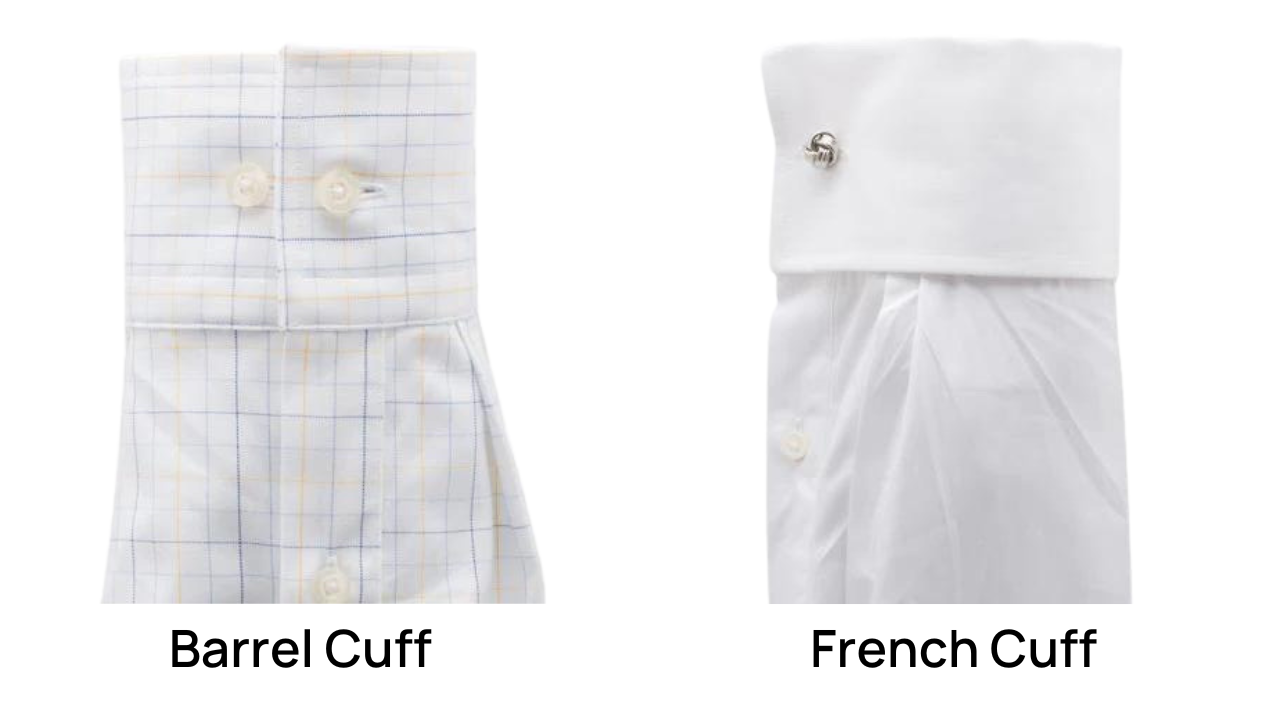
There are two major types of shirt cuffs: French and Barrel.
These should both fit about the same.
Barrel cuffs are the more common option and have a more casual look.
French cuffs are more formal and are designed to be connected using cufflinks.
With your cuffs buttoned, and your arms at your side, the sleeves should barely touch the top of your hand when you bend your wrist so your palms are facing the ground.
The fit of your cuffs around your wrist should be a bit looser than a properly fitting watch. Nothing looser or tighter than that.
Hem
The hem is edge along the bottom of the dress shirt.
Casual shirts (like Oxfords) end a bit shorter and often have flatter hems, dress shirts have scooped hems that extend in the front and the back (the tails) in order to stay tucked throughout the day.
Tails
Dress shirts are designed to have longer tails so they stay tucked in when moving about during the day.
Any brand trying to sell you dress shirts that can be worn untucked is not selling you dress shirts.
They're selling you business casual shirts and should be avoided if you need a proper dress shirt (to wear on formal occasions and with suits, sports coats, etc.)
However, Oxford shirts (detailed down below) can be worn untucked.
Different Types Of Dress Shirt
A lot of guys don't know that there are different types of dress shirts for different outfits and occasions, so let's get you up to date.
These shirts are the ones you need:
Oxford Button-Down Shirt
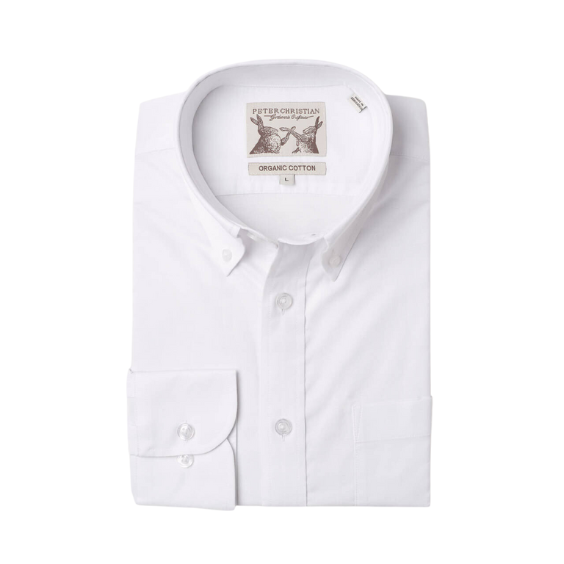
An Oxford Shirt is usually considered a type of dress shirt, but the Oxford shirt is different from a regular dress shirt in two ways:
They usually have a button-down-style collar which eliminates that problem of collars flopping around and/or laying flat and disappearing underneath a jacket’s collar.
The Oxford Shirt is named after the specific weave of the fabric called, you guessed it, Oxford cloth. It has a basketweave structure and a lustrous aspect making it a popular fabric for a dress shirt.
They look great on every body type, and they can easily be worn in both casual and professional settings.
While you can wear Oxford shirts with suits, I don’t dress my clients this way. The buttoned-down collar lends a more casual vibe to the shirt and takes attention away from the formality of a suit. Unless you’re going without a tie when wearing a suit, it’s just not my preference, but it’s acceptable. I normally pair them with a notch lapel suit (no tie), Blazer, Harrington Jacket, sweater, or by itself with the sleeves rolled up.
Semi-Spread Collar Dress Shirt
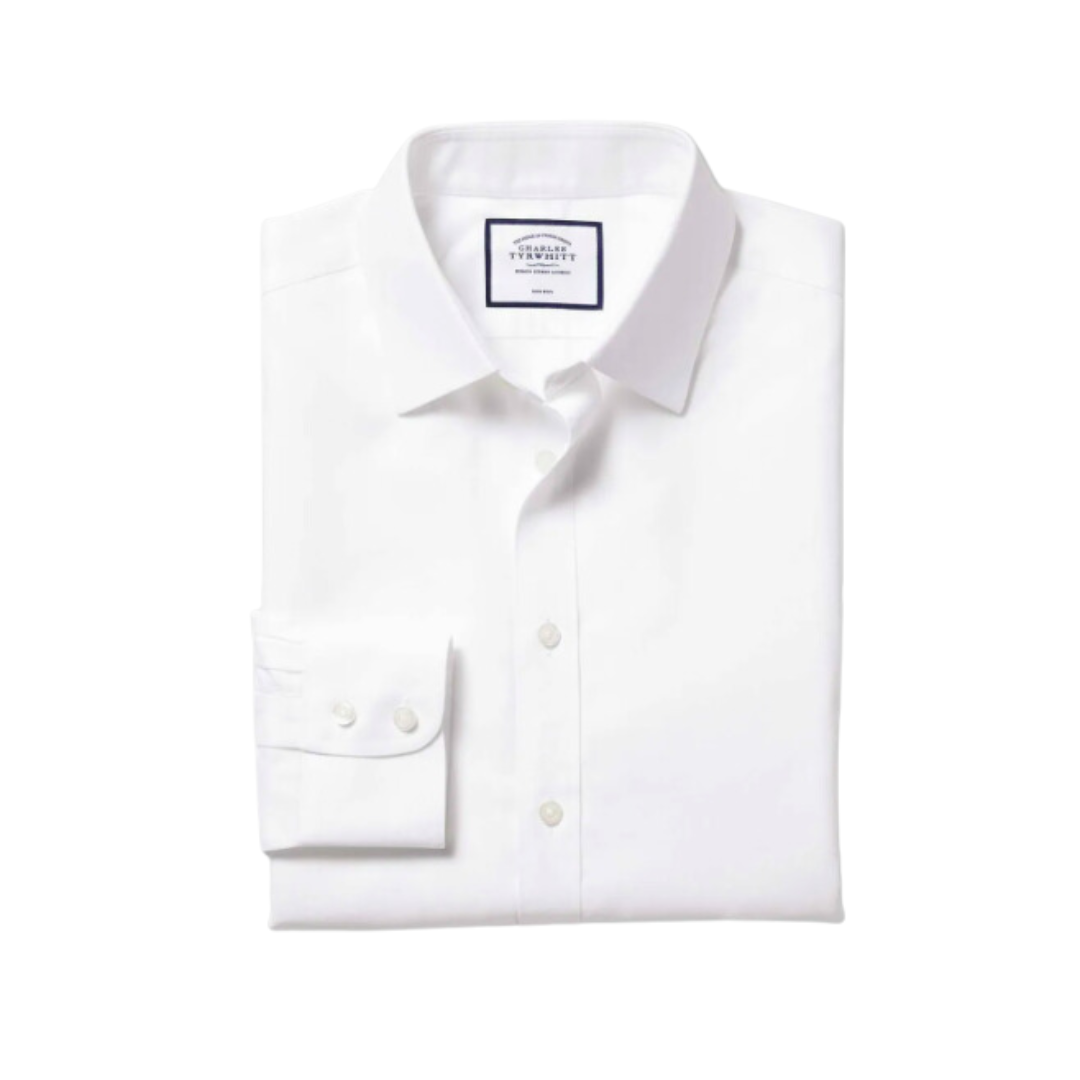
In all your outfits, but especially when dressing up, you want to put your best foot forward, and the Semi-Spread Collar Dress Shirt is the holy grail of dress shirts.
It will look great dressed up or down, with or without a tie, with the sleeves rolled up, underneath a v-neck sweater, or even a leather jacket.
If you’re new to dressing, looking, and feeling better, it’s extremely easy to get bogged down by the minutia. So let me save you the time and just say don’t worry about other collars until later on in your style journey.
And these are the ones that you need to AVOID:
Point Collar Dress Shirt

A point collar, the most common one you’ll see in stores, simply doesn’t look good on most guys because it doesn’t fit most faces or body types. I rarely dress my clients in them because it’s just not worth the hassle when there’s something that looks good on all men.
Whenever I see someone wearing a point collar, they almost always shouldn’t be wearing it because it’s not for them. I’ll do a more detailed post about this later because I can go on forever about my dislike of the point collar.
Spread Collar Dress Shirt
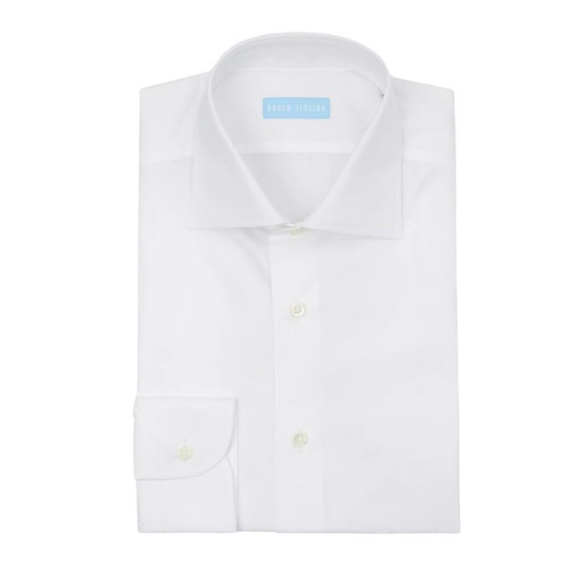
The full-spread collar is similar to the point collar in that it is acceptable in only specific contexts and body shapes. These have gotten more popular over the last few years and I’d choose them over a point collar, if given the choice.
They’re great if you’re wider or broad-shouldered, but I see a lot of guys wearing them who really shouldn’t be. These are also the same guys who have a full Windsor knot to fill in the space of a spread collar, and on thinner guys, this is style suicide! Don’t do it!
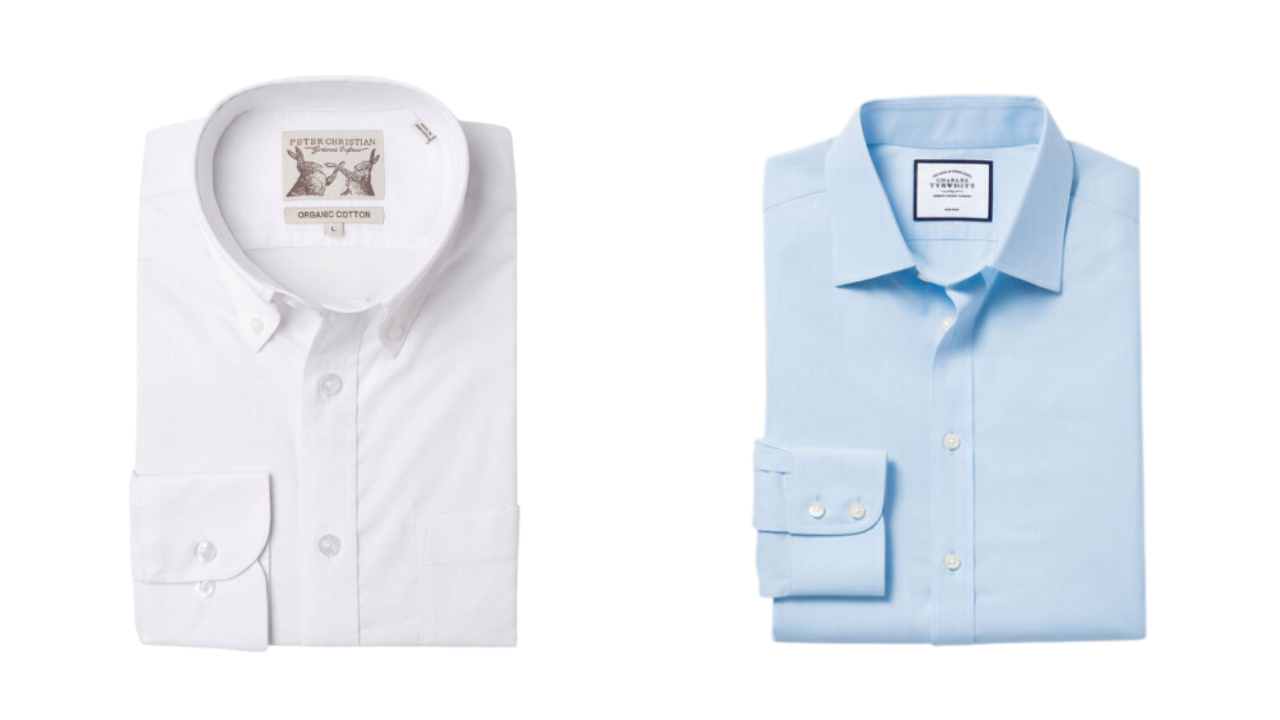
Colors
For both your Oxford button-down and semi-spread collar shirts, you’ll want to stick with white and light blue.
Like the gray suit, these colors act as a blank canvas that goes with anything you pair them with and you can easily add your personality via accessories (ties, pocket squares, etc).
Later on, you can play with the color and pattern, but for right now, these two colors are timeless, sharp, and don’t require any thinking when you put an outfit together.
Fabrics
Oxford Button-Down Dress Shirt
The Oxford Shirt is named always made from Oxford cloth.
Oxford cloth has a basketweave structure and a lustrous aspect making it a popular fabric for a dress shirt. It is soft, comfortable, durable, and less prone to wrinkling than typical dress shirts made of finer silk or silk blends.
Semi-Spread Collar Shirt
Cotton or cotton blends are the preferred fabric options because they always look great and are comfortable.
Some single-digit percentages of lycra or stretch are fine but anything more than 3-5% will just look off.
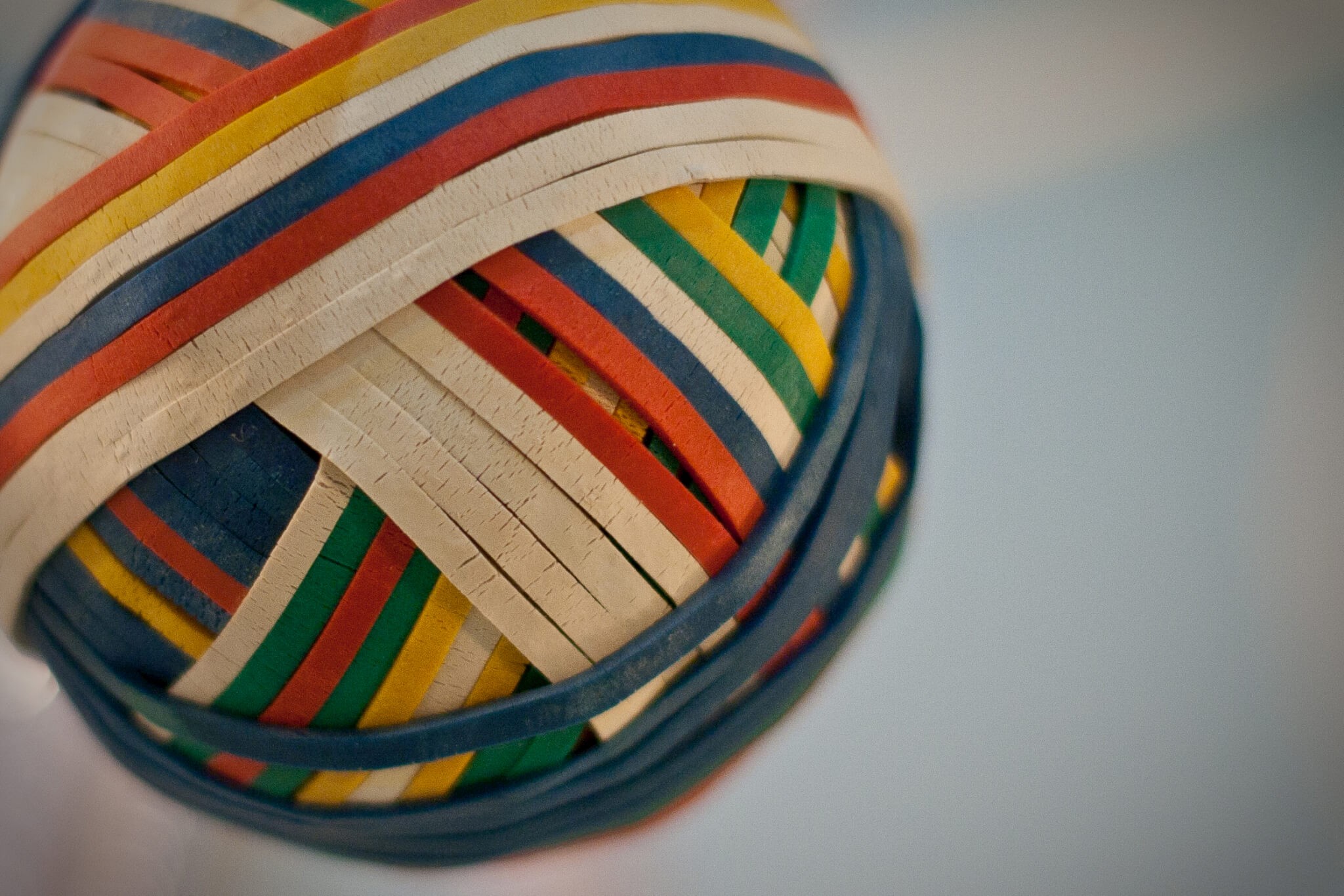
How To Fix Long Shirt Sleeves In A Pinch
Here’s a scenario: you’re getting dressed for an event. Your suit’s been dry cleaned, shoes have been shined, your new dress shirt is ironed and you’re all set to go. You put on your pants, tuck in and button your dress shirt, buckle your belt, tie your shoes, and throw on your suit jacket while giving yourself a once-over in the mirror.
But something looks off.
There’s too much shirt sleeve peeking from underneath your jacket! Most (sloppy) guys will shrug it off and continue their night like it’s no big deal.
Please don’t be like most guys!
There's a quick and simple fix.
1. Grab 2 rubberbands.
Make sure they’re large enough to wrap comfortably around your forearm without cutting off your circulation.
2. Remove your jacket, if it’s on. Place a rubberband over your sleeve, onto your forearm.
Around the middle of forearm, where there’s the most meat.
3. Tug your shirt sleeves up until your cuffs hit your wrist (this is the appropriate sleeve length).
Your cuffs should end at the bend of your wrist. Bend your wrist up and your shirt cuff should be barely touching the top of your hand.
4. Repeat for the other arm.
5. Throw on your jacket, adjust as needed and you’re ready to go!
Make sure that only about 1/2 of cuff is showing from underneath your jacket. If your jacket’s sleeves are short, adjust your shirt sleeves to only peek out a half inch. It’s better to have shorter sleeves with proper cuff spacing, than the opposite.
The rubberbands will hold your sleeves all night long. Just make sure, that if you remove your jacket at some point throughout the night, to take the rubberbands off your forearms. You’ll get some odd stares if you don’t.
How a Dress Shirt Should Fit
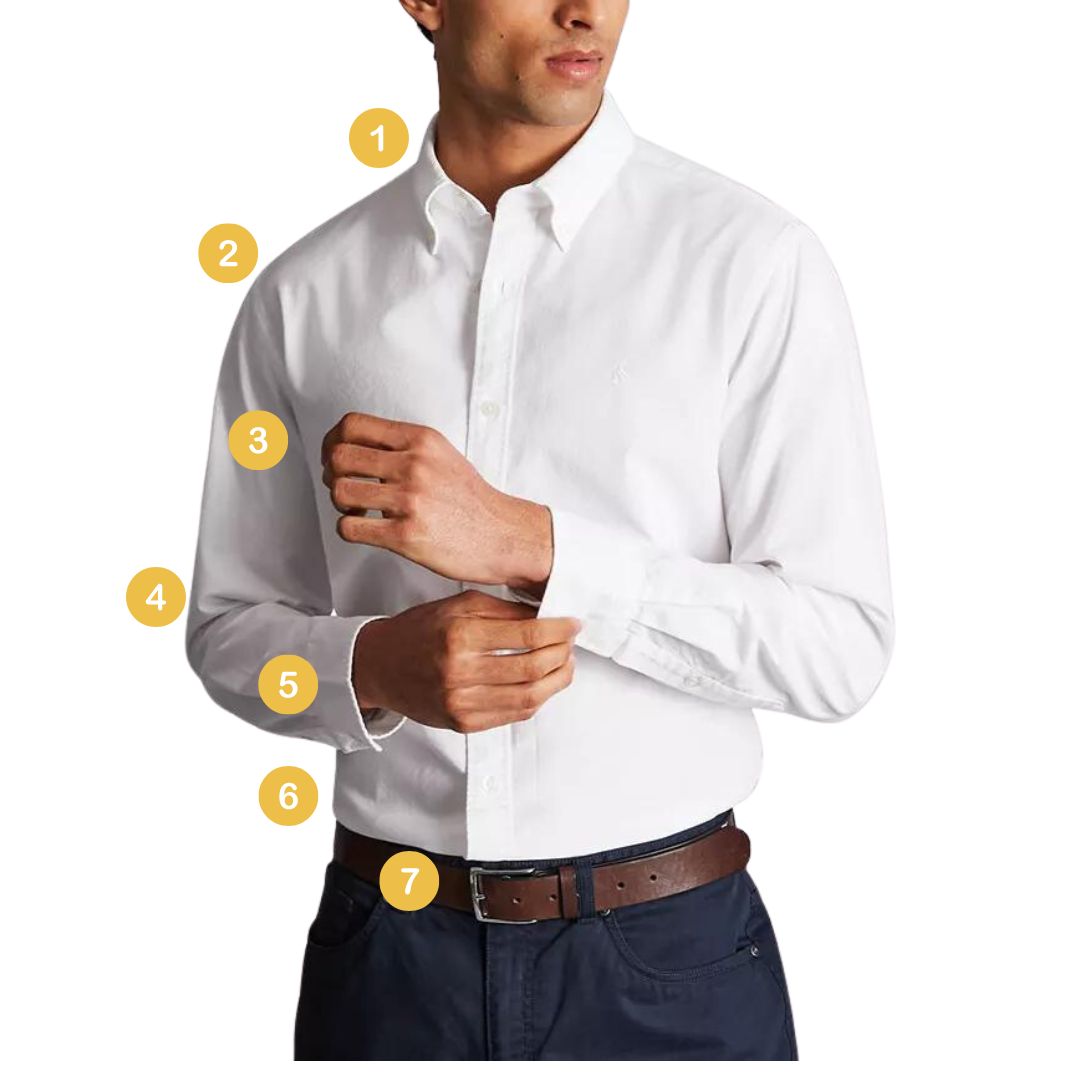
The collar should lightly hug your neck without constricting it when buttoned. You should be able to fit one finger between the neck and collar.
The shoulder seam should be right where your shoulder starts sloping down to your arm.
Armholes should be comfortable in motion and shouldn't be digging into your armpit or look loose. The chest should be snug but not so tight that it pulls on the button. The picture above is about perfect but on the edge of being too tight.
Your sleeves should not be so tight that you can see the details of your arms, but they should also not be so loose as to billow and bunch at the wrist.
The sleeve/cuff should end right at the bend of your wrist and slightly peek out from under a jacket sleeve.
You shouldn’t be able to pinch more than 2-3 inches (5-7.5cm) of fabric on either side of your belly button.
If you’ll wear the shirt with a front tuck, it should end around the mid-crotch area (between the button of pants to the top of the ^ of the legs), at the shortest, and if you'll be wearing it fully tucked in most of the time, it can be longer than this.
Bonus tip: That belt is way too big/long. That's a lot of excess flap.
Want to see how your ITEM should fit specifically for your age, height, body type, and skin tone?
Oxford Button Down Dress Shirt Outfit Ideas
Casual

Blue Oxford Button-Down Dress Shirt
Gray Shorts
White Low-Top Sneakers
When the weather starts to heat up, an Oxford dress shirt is a smarter alternative to your go-to crewneck t-shirt. White would also work here and you can always swap out those gray shorts for a tan or navy pair instead.
Elevated Casual
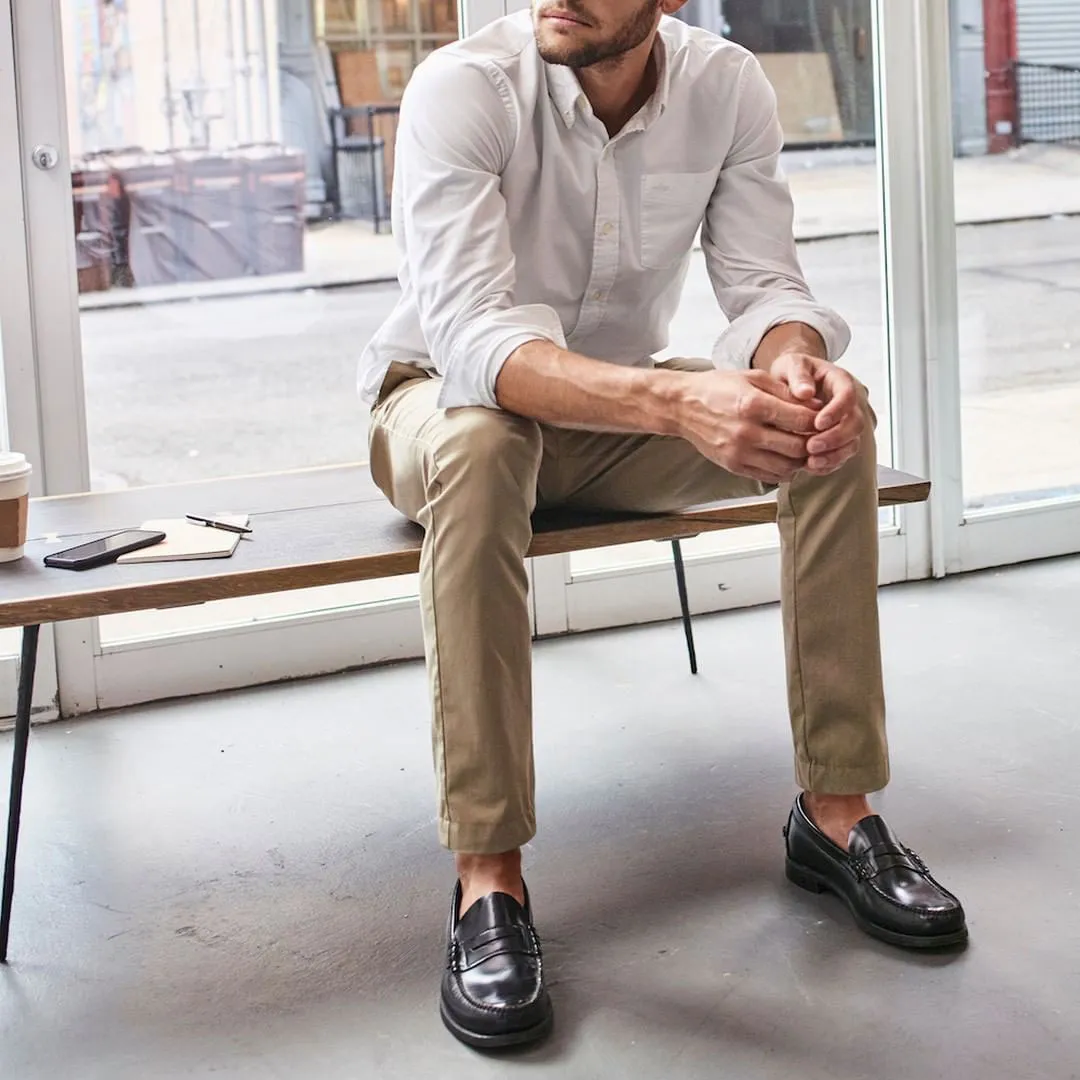
White Oxford Dress Shirt
Tan Chinos
Black Loafers
If the black dress shoes are a bit too heavy for your liking, then you could always swap them out for a pair of brown Oxford dress shoes instead. Navy chinos would also work here or if you wanted to dress it up further, you could go for a pair of navy or charcoal wool trousers.
Business Casual

Charcoal Sports Coat
White Oxford Button-Down Dress Shirt
Dark-Wash Jeans
Brown Dress Shoes
This outfit proves that sometimes the best looks are also the easiest to put together. Every element fits like a dream here and if you wanted to add an extra layer of insulation, a black v-neck sweater would also look great layered over the dress shirt.
Want to see more outfit ideas for the different items in your wardrobe?
Semi-Spread Collar Dress Shirt Outfit Ideas
Elevated Casual
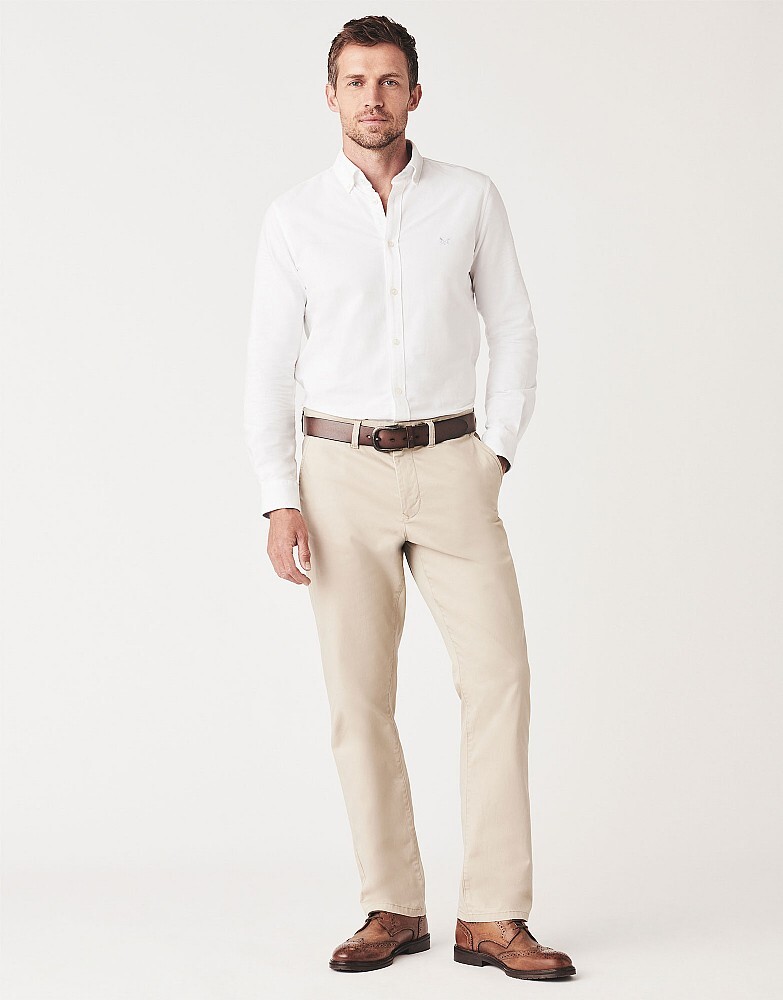
White Dress Shirt
Tan Chinos
Brown Dress Shoes
This outfit pairing is crisp, simple, and oh-so-smart! Swap out the Oxford shoes for some low-top sneakers or boots if you're looking to dress it down. Change up the chinos for some dark wash jeans or wool trousers if you're looking for something a bit dressier.
Business Casual
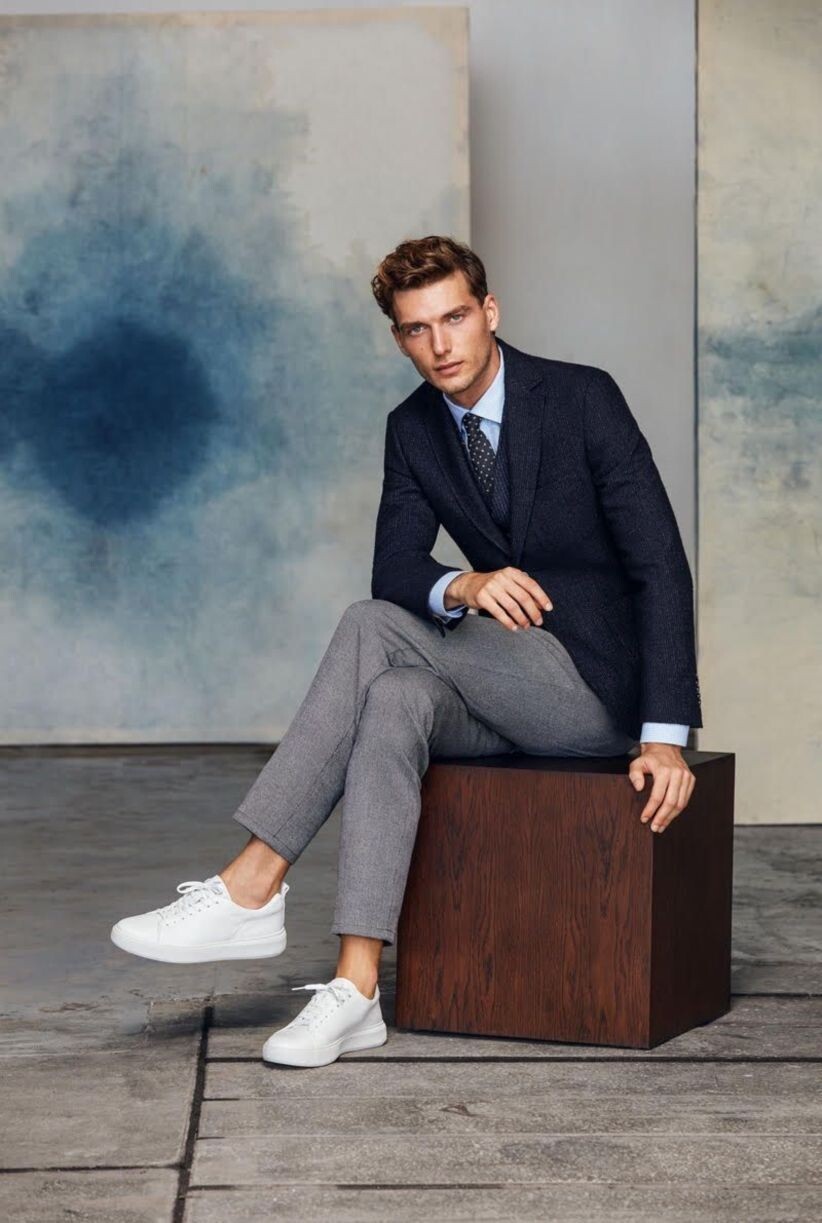
Navy Sports Coat
Blue Dress Shirt
Navy Tie
Gray Wool Trousers
White Low-Top Sneakers
Here we can see how a dress shirt works as the perfect foundation for your stylish business-casual outfits and take note that you should really only wear a tie if you're wearing a jacket (sports coat/ trucker/ bomber) over your shirt. Also, remember to keep those white sneakers impeccably clean and you should also be tucking in the laces for a more elevated and polished look.